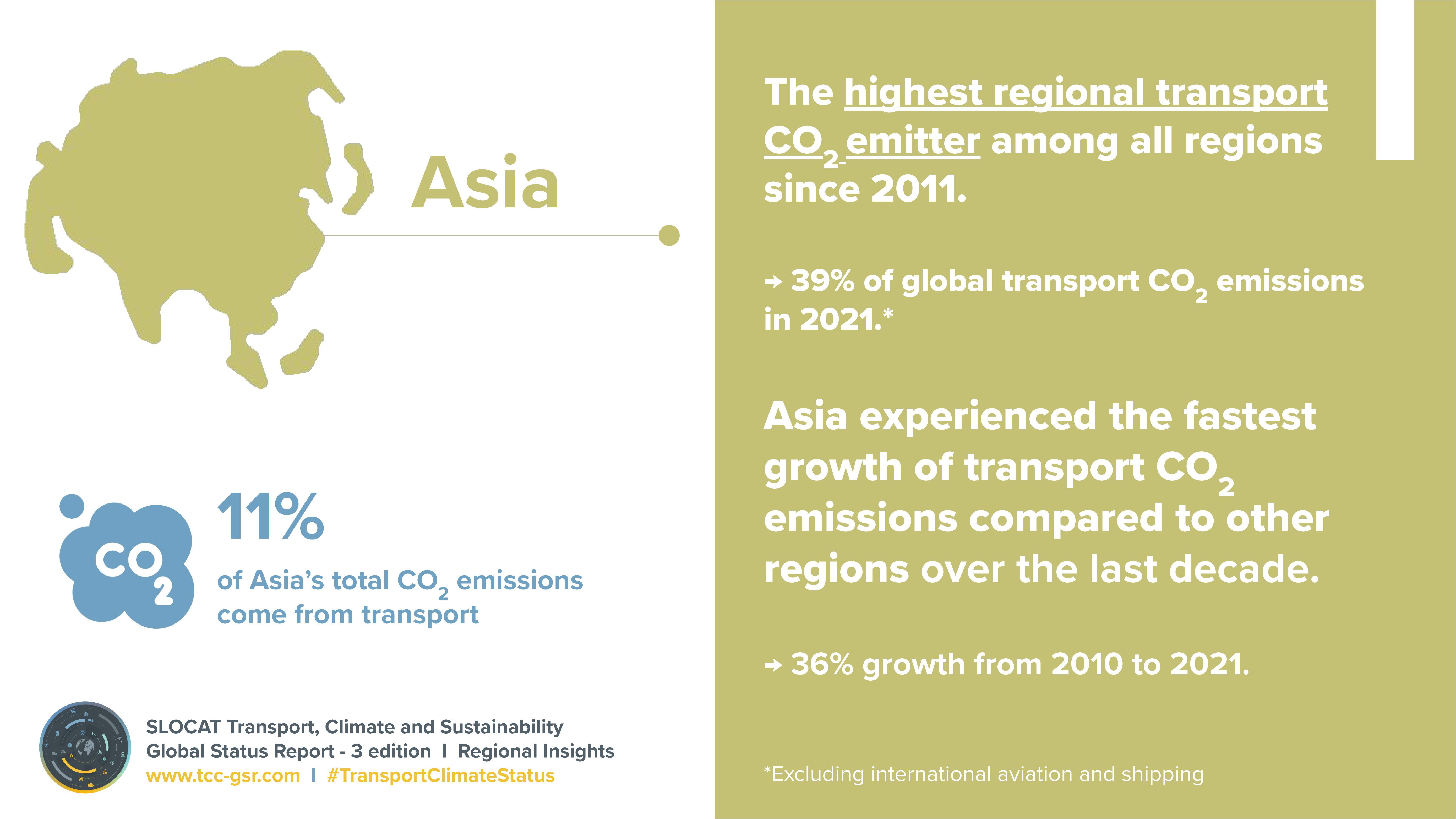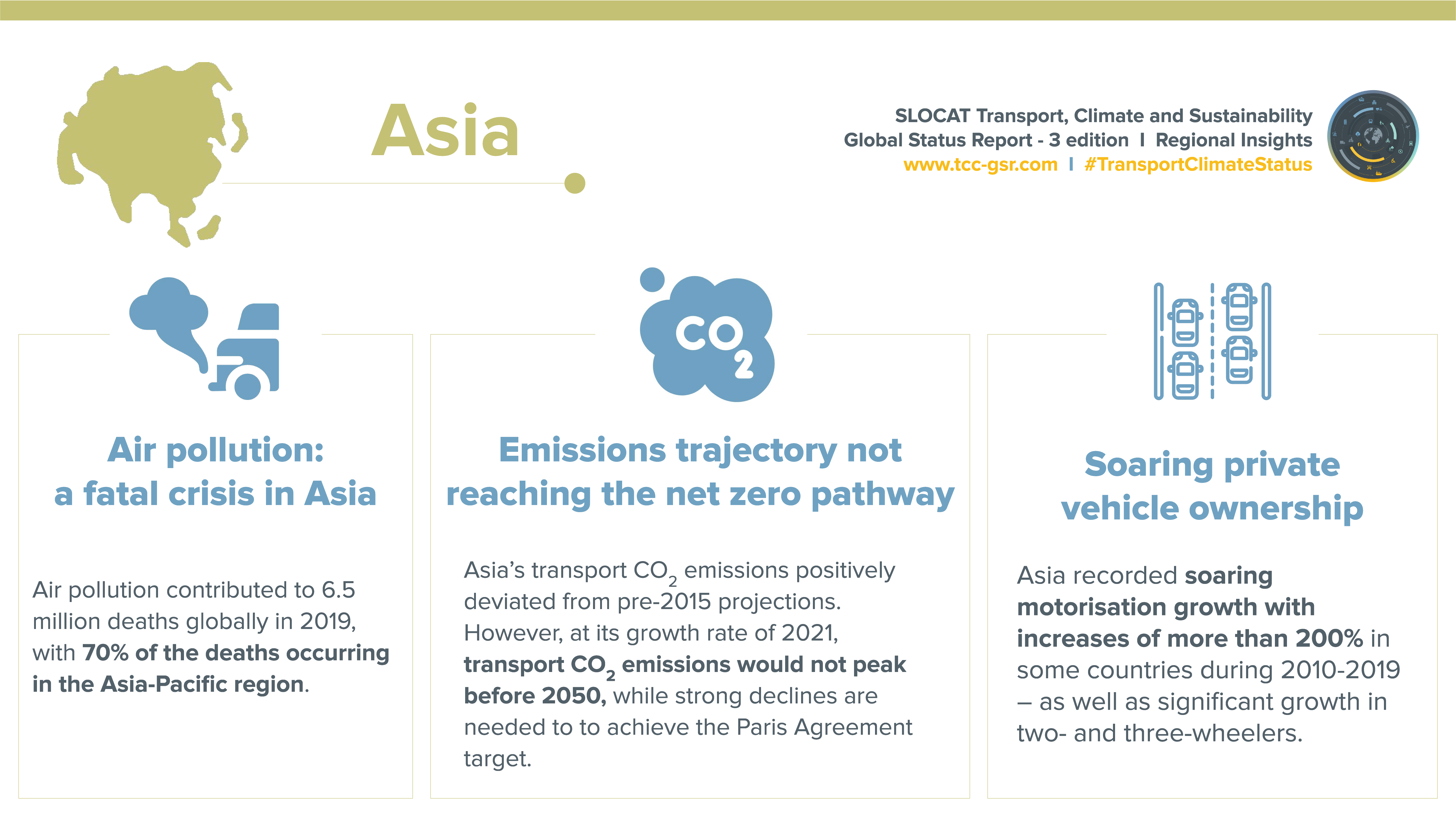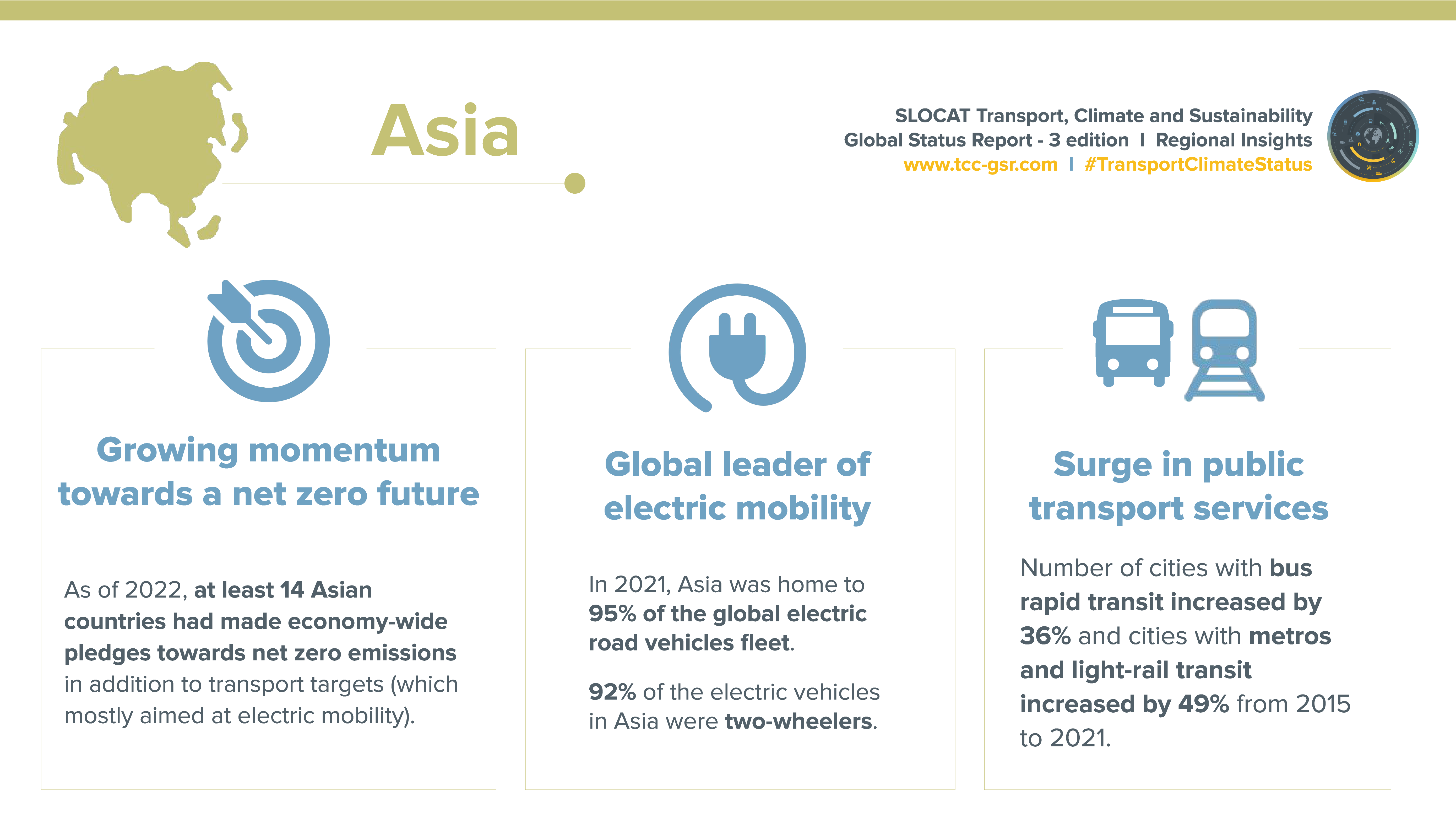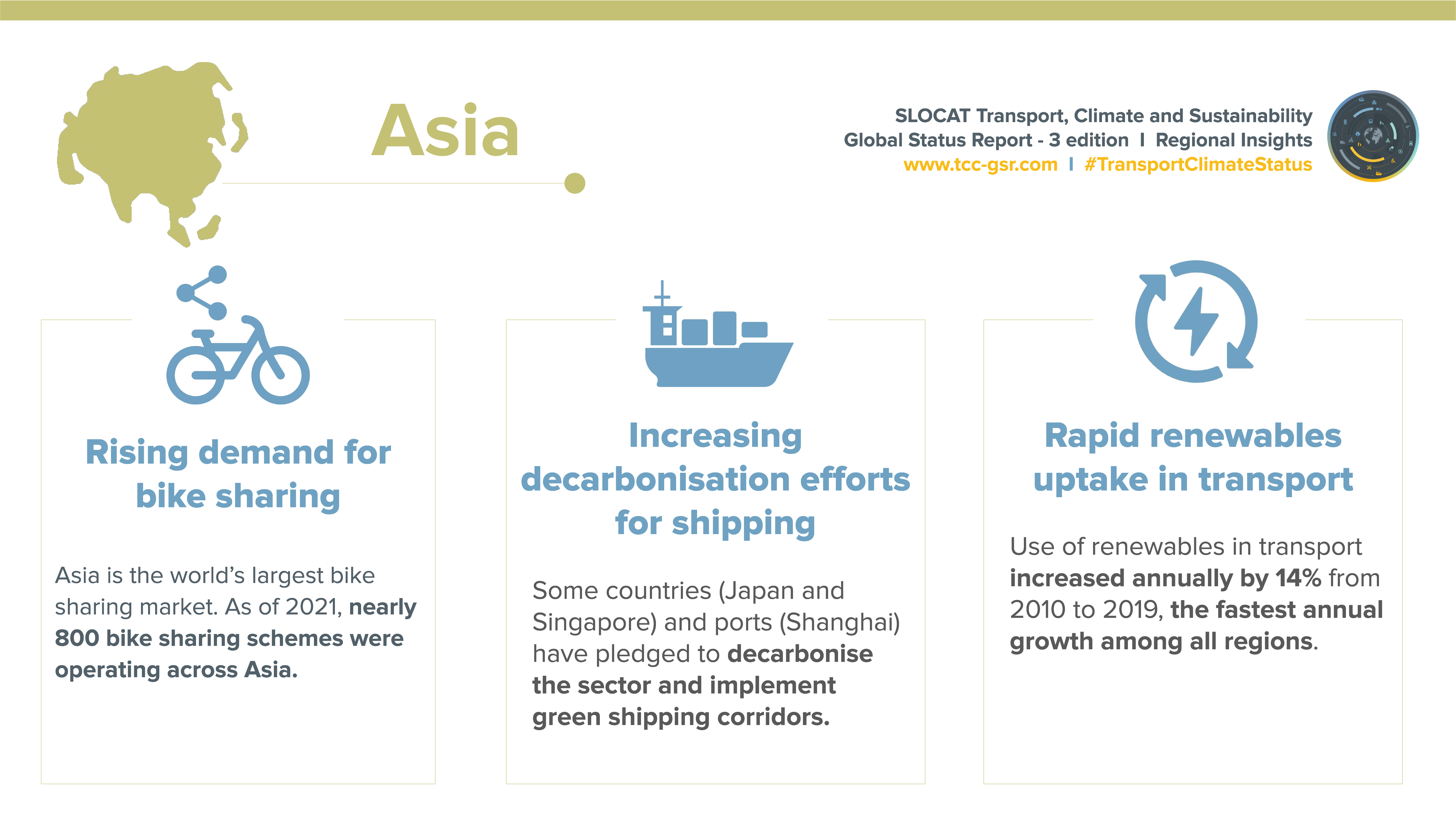-
 Asia Regional Overview
Asia Regional Overview
Population size
(2022)
Population growth
(2010-2022)
%
Urban population share
(2022)
%
Urban population
growth (2010-2022)
%
GDP per capita
(2021)
GDP growth
(2010-2021)
%
- Key Findings
Demand trends
- As their populations and economies expand, countries across Asia have recorded soaring motorisation growth (covering four-wheeled motorised vehicles) – with increases of more than 200% in some countries during 2010-2019 – as well as significant growth in two- and three-wheelers.
- Asian countries continued to be global leaders in electric vehicles. As of 2021, the region was home to 95% of the world’s electric vehicles, with nearly 92% of the Asian fleet being two-wheelers.
- Cities in Asia have experienced a surge in public transport, led by a strong increase in metro rail.
- Between 2015 and 2021, the number of Asian cities with bus rapid transit systems increased 36%, while cities with metros and light-rail systems increased 49%.
- Informal transport through two-wheelers, three-wheelers, Jeepneys and other types of collective transport continue to play a significant role in many parts of Asia.
- The demand for bike sharing services in Asia has risen since 2020, making the region the world’s largest bike sharing market. As of 2021, nearly 800 bike sharing schemes were operating across Asia.
- Passenger air travel in Asia had partially rebounded from the COVID-19 pandemic by late 2022 and showed stronger recovery than in other regions. Globally, passenger air travel increased 57% by September 2022 compared to 2021, whereas the Asia-Pacific region saw an increase of 465% (although global averages were still 74% below pre-pandemic levels).
-
Decreased economic activity during the pandemic, followed by the Russian Federation’s invasion of Ukraine, led to significant shifts in freight transport across Asia.
- The Asia-Pacific region has experienced the fastest uptake of renewable energy use in transport globally, with average annual growth of nearly 14% between 2010 and 2019 (although starting from a low baseline).
Emission trends
- Asia continued to have the highest transport-related carbon dioxide (CO2) emissions among world regions, as well as the highest transport emissions growth, at 36% during 2010-2021.
- China remained the largest emitter of transport CO2 in Asia and the second highest emitter globally as of 2021, followed by India, although Persian Gulf countries still dominated per capita transport emissions.
- China continued to see slight decreases in transport emissions in 2022 as lockdowns remained in place, whereas restrictions had been loosened in many other Asian countries. In countries such as India and Japan, transport emissions increased consistently, in part rebounding from lows during the pandemic.
- Air pollution contributed to 6.5 million deaths globally in 2019, with 70% of the deaths occurring in the Asia-Pacific region.
- Recent projections have shown that transport emissions in Asia deviated from pre-2015 projections, which had predicted a near-doubling in business-as-usual emissions between 2021 and 2050. Even so, at the growth rate of 2021, the region’s transport emissions would not peak before 2050, whereas a net zero emissions pathway or a pathway consistent with keeping global temperature rise below 1.5 degrees Celsius would require emissions to peak by 2025.
Policy developments
- As both population and urbanisation increase in Asia, governments will need to boost efforts to achieve sustainable transport while meeting the rising demand for passenger and freight transport.
- As of 2022, at least 14 countries in the region had made economy-wide pledges towards net zero emissions, in addition to having transport-specific targets, mostly aimed at electric mobility.
- Several Asian countries and cities have prioritised electric mobility in their policy targets, with some adopting targets to reduce or ban sales of internal combustion engine vehicles.
- Some transport-specific targets are aimed specifically at improving the efficiency of the freight sector, ranging from reducing energy use to increasing efficiency and multi-modality.
- Specifically for shipping, some countries and ports in the region pledged to contribute to efforts to decarbonise the sector.
- Policies focused on sustainable mobility have continued to expand in Asia, as more countries develop policy frameworks supporting low-carbon urban mobility, as well as freight transport.
- Informal transport fleets in Asia are gradually electrifying, for example in the Philippines.
-
Some Asian countries have adopted sweeping measures towards low-carbon mobility and reductions in vehicle travel, while cities have increasingly created sustainable urban mobility plans (SUMPs), often to decongest urban areas.
- Measures to support cycling are on the rise in Asian cities, with governments such as India, Indonesia and the Philippines launching initiatives since 2020 to support walking and cycling.
- A few Asian countries have long implemented fuel efficiency standards, including China, India, Japan and the Republic of Korea. As of 2022, only five countries globally had fuel economy standards for heavy-duty vehicles, among them China, India and Japan (along with Canada and the United States.
- Asia’s global dominance in electric mobility has been driven by national efforts to implement specific policies and to remove barriers, as well as in some cases by initiatives to swap, recycle and re-use electric vehicle batteries.
- As countries in Asia have focused on increasing their renewable energy capacity, the most common policy measure aimed at the use of renewables in transport continued to be biofuel blending mandates, with three countries (India, Indonesia and the Republic of Korea) increasing their mandates in 2022.
Authors: Hannah E. Murdock, Imperial College London; Ambika Sairam, SLOCAT Secretariat
Contributor: Urda Eichhorst, GIZ





